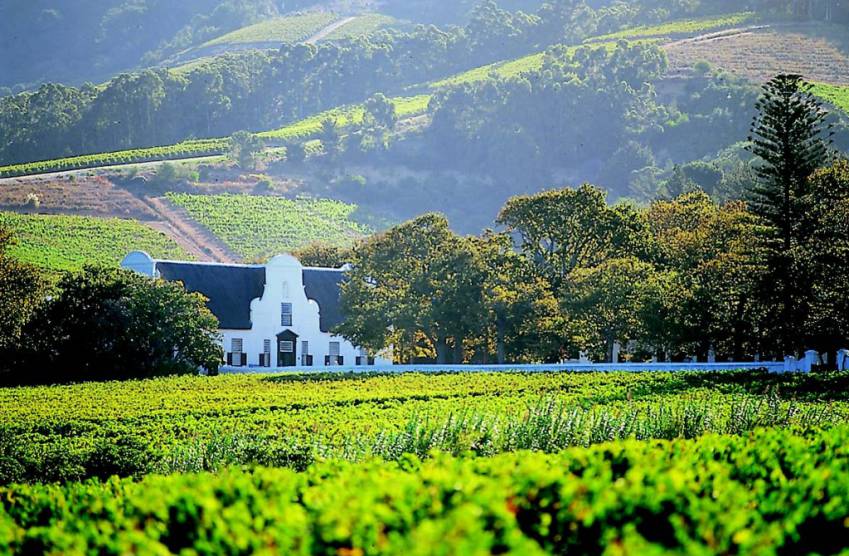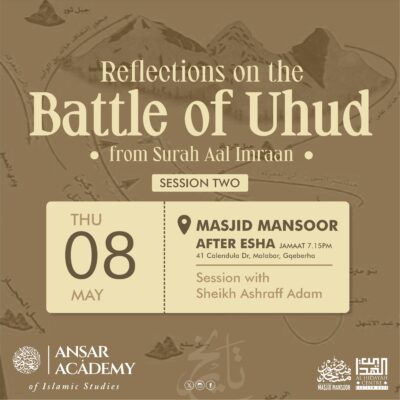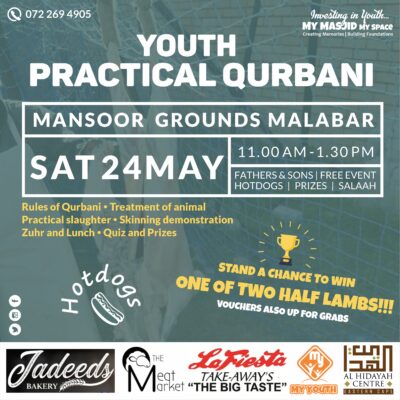The area of Constantia in Cape Town is now an affluent suburb of the city. It was originally the forest used to supply the Dutch settlement in the Cape in the 1600’s. The Dutch were at that time expanding their trade empire in the region of today’s Malaysia and Indonesia. This was the basis of colonialism: exploiting people and resources of other countries to personal gain and enrichment. This continues today in the way the western financial system is designed. Economic control over former colonies together with offshore tax havens and other financial tools favour the former colonial rulers.
In 1667, the Dutch defeated the Muslims in Sumatra and one of the rulers Sheikh Abdur Rahman Matebe Shah along with two of his religious advisers was exiled to the Cape. One was bundled off to Robben Island while Sheikh Abdur Rahman and Sayyid Mahmood were sent to the Constantia Forest. They were brought over on the ship the Polsbrook and are regarded as some of the first to bring Islam to South Africa’s shores.
Sheikh Abdur Rahman was confined in the forest near a stream. He would take Wudhu from this stream and worship Allah Ta’ala. He took the opportunity this presented to teach the slave population in the vicinity about Islam. This was possibly the first informal Madressa in South Africa. He passed away in 1681 or 1682 and is buried where he taught Islam. The stream still runs alongside his resting place. This was before the arrival of Sheikh Yusuf Macassari rahimahullah in 1693 who set up the first Muslim community.
Interestingly in 1788 one of the ambassadors of the Tipu Sultan of Mysore, India visited Constantia while on his way to France to negotiate an alliance with Napolean Bonaparte against the British. This would make him one among one of the early Muslim presences in Constantia.
Constantia has two old Masjids. In the early 1900’s the road from Wynberg through Constantia to Hout Bay was a rough sand one surrounded by farmland and bush. In 1902 Dawood Sadien bought Sillery Farm in Constantia and in 1913 donated a portion to be used as a Masjid. This became Masjid Mahmood. Bricks for the construction were delivered by horse-drawn wagons.
The other one is Masjid Monier which predates Masjid Mahmood and was established in 1883. During Apartheid, Constantia was zoned in 1961 as a White’s area. In the late 1960’s the non-Whites were forcibly removed to Mitchells Plain and other areas. The Muslims managed to keep both the Masjids going by coming regularly for special programs. Today these Masjids once again serve as fully functional hubs for Muslims who have moved back into the area.
Masjid Monier has an old Muslim graveyard attached to it with some noteworthy graves. Among the more recent ones is that of Sheikh Saalih Abadi, the father of Hifz in South Africa. He passed away in 1999. His father had come to Cape Town from Yemen. Sheikh Saalih became a Hafiz at the age of 15. He then left for Makkah Mukarramah in 1927 and stayed there for 12 years gaining Islamic knowledge. He was bestowed with an Ijaza (permission) in the Riwayat of Hafs form of reading the Noble Quran by one of the Imams of the Haram. Back in South Africa he dedicated his life to the Noble Quran and served as Imam in Durban’s Grey Street Masjid for a while before settling in Cape Town. It is estimated that through his students over 1,000 people in South Africa have to date memorised the Noble Quran.
The European political struggles were having an impact on places across the world and the Cape was no different. The Anglo-Dutch War saw the Battle of Muizenberg take place in the Cape. This saw the British take control of the Cape in 1795. This became an opportune moment for a personality like Imam Abdullah ibn Qadhi Abdus Salaam popularly known as Tuan Guru. He had been imprisoned for 12 years on Robben Island by the Dutch as a political prisoner from Tidore. He was a prince of Tidore in the Ternate Islands of Indonesia and was regarded as a threat to the Dutch in the Muslim struggle for independence.
While on Robben Island he wrote several copies of the Noble Quran from memory as well as books on Fiqh and Aqeedah. These became the primary reference works for the Muslims in the Cape in the 19th century. On his release he was 81 years old and agitated for Muslims to be allowed to worship openly. He set up a Madressa in what is now the Bo Kaap area of Cape Town in 1793. He tried for a Masjid but was not given permission by the Dutch. Undaunted, he led the Muslims in public Juma prayers in a disused quarry. When the British took control of the Cape in 1795 at the Battle of Muizenberg, Tuan Guru got permission from them to establish a Masjid. The building was made Waqf by a Muslim lady, Sartjie van de Kaap and became the first Masjid in South Africa known as the Auwal Masjid.
This was followed by Palm Street Masjid and Nurul Islam Masjid in Cape Town. The fourth Masjid in the country and the first to be built from ground up and the first with a Minaret was Masjid Qudama in Uitenhage. In the Jubilee Park cemetery in Uitenhage lies Imam Jabaruddin, known as Jan Bardien who owned several properties. He established Masjid Qudama in Caledon Street, Uitenhage on one of these properties. The Muslims of Port Elizabeth would leave by ox cart on Thursday nights to participate in the Juma in Uitenhage as the city had no Masjid as yet.
The lessons we take away are that:
- Our forefathers made Islam a priority in their own lives no matter what their circumstances and imparted this to others especially by establishing Masjids and Madressas. We should not rest on their achievements but need to look at how we can support our Masjids and Madressas to leave our legacy behind.
- Learn history to gain an astounding glimpse into how the Taqdeer and system of Allah Ta’ala works. Events halfway across the globe can impact on our lives in both positive and negative ways. Trust the decisions of Allah Ta’ala and aim to please Him so that things fall in our favour.








COMMENTS